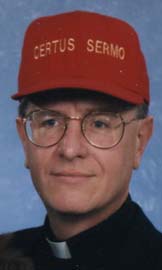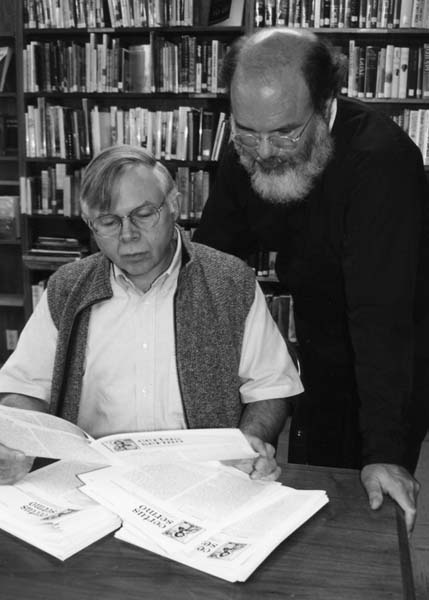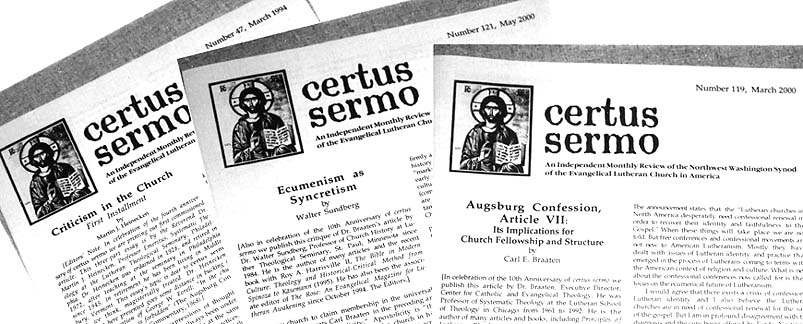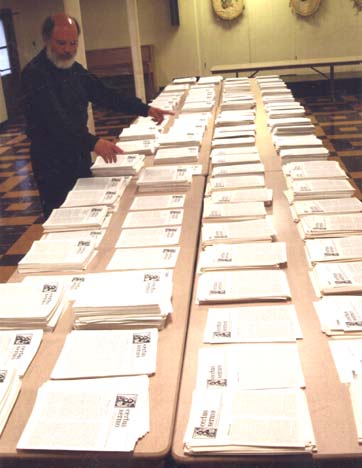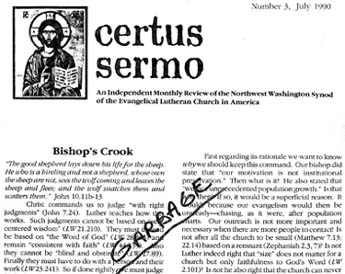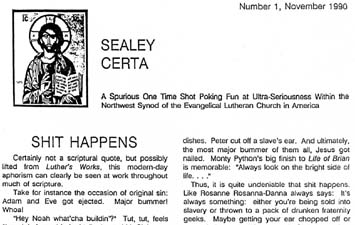|
The Story of Certus Sermo: Celebrating Christian Norms Through
Independent, Public Criticism in the American Lutheran
Church
at the End of the 20th Century (November
2007) An
Unlikely Story This
is the unlikely story of a small regional church newsletter with the odd
name of certus sermo that kicked up quite a ruckus. It was published monthly
between May 1990 and August 2001, with a total of 136 issues being
printed – the last three never being mailed out due to being finished
three years behind schedule. Authors This
publication was dreamed up by Ronald F. Marshall, Pastor of First
Lutheran Church of West Seattle and Jon Richard Nelson, Pastor of Maple
Leaf Lutheran Church at a pastors conference in
Nelson worked on the first 60 issues with
Marshall and Baker and then resigned. In the announcement of Nelson’s
retirement in issue 61 (May 1995), Marshall and Baker said, “We give
thanks to God for his theological fidelity and continued friendship.”
The remaining 76 issues were written by Marshall and Baker, without
Nelson’s help. All three of these ELCA pastors graduated from Luther
Seminary in The over ten years of publishing certus
sermo came to an end when Marshall and Baker decided on August 24,
2004 to quit writing it. The reason was that Baker no longer had enough
time to devote to its publication.
Guest
Writers In
celebration of the fifth and tenth anniversaries of certus
sermo, ELCA notables were invited to write for issues 47-49 and
119-121. The Rev. Dr. Martin J. Heinecken (1902-1998) wrote on
“Criticism in the Church” for the fifth anniversary. He was
Professor Emeritus in Systematic Theology at the Lutheran Theological
Seminary in For our tenth anniversary we invited the Rev. Dr.
Carl E. Braaten and the Rev. Dr. Walter Sundberg to debate the concordat
between the ELCA and the Episcopal Church (numbers 119-121). Dr. Braaten
was Professor of Systematic Theology at the Lutheran School of Theology
in Dr. Sundberg has been Professor of Church History at
Luther Seminary, The fact that Heinecken, Braaten and Sundberg would
write for certus sermo
considerably increased the credibility of certus
sermo among its critics.
Name Pastor
Marshall came up with the name of certus
sermo and Nelson and Baker quickly agreed to it (with the subtitle
being An Independent Monthly
Review of the Northwest Washington Synod of the Evangelical Lutheran
Church in America). In the first issue, the meaning of this name was
explained: “This review’s name, certus
sermo, is Latin for “sure word,” and comes from Martin
Luther’s 1527 commentary on Titus: ‘Two things are particularly
necessary… in the office of teaching…. First let him have a sure
word (certus sermo) and be
sure that he has the Word of God…. Once he has this Word, then he will
not only teach, but is able to teach and to denounce or to convince….
Therefore the faithful shepherd is one who not only feeds his flock but
also protects it…. The truth is a sure word (certus
sermo), while the word of empty talkers is a seduction’ (Luther’s
Works 29:32, 33, 35).”
This name drew much scorn. The fact it was in Latin made some
think it was pompous. The fact it denoted certainty made others think it
was arrogant. Even though we traded on Luther’s distinction between
rank arrogance and that which is born of the Spirit (Luther’s
Works 24:118) (number 27), our critics didn’t care. Their minds
were made up and they didn’t want to be confused with the facts.
Dialogue, for them, was a waste of time. Their only interest was in
ridiculing and silencing certus
sermo. Purpose In
the first issue, on the back page, and reprinted in ever subsequent
issue, we stated our fourfold purpose in writing certus
sermo: “We write this
monthly review to stimulate vigorous conversation in our parishes, to
focus and spread unofficial views on our synod’s ministry, to nurture
a deliberate and detailed vantage from the Bible and the Lutheran
Confessions, and to overcome the isolation of the synod’s pastors.” The key to this rationale was the third part
regarding the Bible and the Lutheran Confessions. This point is no
surprise since for many years the Church has been drifting away from the
historical norms of Christianity. One therefore would expect to see it
also happening in our synod – which we did and therefore sought to
remedy. So as the church historian extraordinaire,
Jaroslav Pelikan argued, emphasizing “affective sentiments” over the
obligation to confess the truth of church dogmas, effectively
“buried” Christian norms and church doctrine in the modern era [The
Christian Tradition, 5 vols. (University of Chicago Press,
1971-1989) 5:122-123]. Certus
sermo was about resurrecting those buried norms. But as the writers
soon found out, those who had buried the norms didn’t take kindly to certus
sermo popping open coffins in the ecclesiastical graveyard. They
quickly pounced upon the scene, slapping down the broken-up ground with
their shovel blades in hopes of killing certus
sermo and keeping the Christian norms buried underground where they
belong – according to the wishes of the modern world. Format Each
issue of certus sermo had four
8½ by 11 inch pages, with two columns on each page, spread out over one
11 x 17 inch sheet of paper, folded in half. On the front page were two columns devoted to a
section called the “Bishop’s Crook.” The bishop’s crook or staff
or crozier is an ancient symbol for the office of the bishop (see number
66). Some thought this title was actually a veiled attack on our bishops
– calling them crooks! But this allegation was baseless. John 10.11-13
was the preface of this section: “The good shepherd lays down his life
for the sheep. He who is a hireling and not a shepherd, whose own the
sheep are not, sees the wolf coming and leaves the sheep and flees; and
the wolf snatches them and scatters them.” Sometimes this section was
longer than one page but never less than that. By issue 15 (July 1991)
the one page limit was set. This front page section was the most
controversial part of certus sermo.
This was because in it we often examined the public statements and
writings of our local bishop. This usually included constructive
criticisms, but also, at times, unqualified praise – something which
always went unnoticed by our critics in their complaints about us. Other
times this page was devoted to an exposition of an exemplary bishop from
church history – like We always agreed with our supporters on this matter.
We always found our criticisms of the bishops to be timely, germane and
constructive. To show what we mean, here are a dozen examples from the
“Bishop’s Crook” column to show what we mean: [1]
When Bishop Knutson wrote in August 1990 that we should take the movie Jesus of Montreal as a good example of effectively communicating the
Christian faith, we disagreed, since this movie makes Jesus say “I am
not Christ” and you must “save yourselves.” Both of these
statements conflict with Biblical and Lutheran Confessional teachings
(see number 5). [2] And when
Bishop Knutson reported in August 1991 on the church assembly in
Orlando, FL, saying we should rejoice in our diverse opinions within the
church knowing that our unity “rest on Jesus Christ” and not on our
common agreement in other matters, we protested because of the
importance in also agreeing on our doctrines regarding who Christ is,
what he says and what he does (see number 18). [3] And when he invited Juanita Batzibal to offer a Mayan prayer at
the pastors conference in Seattle on May 28, 1992, in which she implored
the Earth to forgive us for polluting it, we balked, since only God can
forgive sins by way of Jesus’ sacrifice on the cross (see number 26). [4]
And when Bishop Knutson in June 1992 advised us to follow guidelines
which say we should avoid addressing God as “Father, Son or Lord,”
we again protested since Holy Scriptures and the Lutheran Confessions
clearly address God in this way (see number 33). [5]
And when he in August 1993 commended Luther’s statement that
Christians are to witness in their “ordinary lives as representatives
of Jesus in the world,” we criticized him for leaving out that we are
first of all to “offer our grateful worship to God in church,” and
only them move out into the world (see number 41). [6] And when Bishop Maier, at a pastors conference in Marysville,
WA, on October 19, 1995, said that Lutherans are free to “shape”
their own conscience on matters of homosexuality, we disagreed, since
honoring ones own conscience never implied for Luther making up your own
sexual morality (see number 66). [7]
And again when Bishop Maier wrote in November 1995 that we are to invite
new people to church “to delight for themselves in the open embrace
offered them by Jesus Christ,” we criticized him for excluding from
this invitation to these new folks any call from Christ Jesus to repent
as well (see number 67). [8] And when in his Easter sermon on April 7, 1996, he said
“Christ is risen!.... But Jesus is not here,… he has ascended,….
but we are here to say Jesus is here,” we protested this reduction of
Christianity to depending on the kindness of strangers (see number 72). [9]
And when Bishop Maier in September 1996 challenged the synod to greater
“effectiveness,” we protested asking why this wasn’t linked to a
call for greater faithfulness as well (see number 77). [10] And when he in December 1996 favorably quoted a scholar for
telling us to “listen” to unbelievers in order to welcome them into
the church on their own terms, we criticized him for intentionally
cutting from this quote the additional need to assess the rebellion and
cynicism of these same unbelievers – and not just let them come into
church with no scrutiny at all (see number 80). [11]
And when Bishop Maier in September 1997 said that “nobody” won in
the defeat of the concordat with the Episcopal Church since it was by a
slim .6% margin, we disagreed, since when he was elected bishop by a
slim .7% margin he didn’t say there had been no bishop elected –
denying thereby that what’s good for the goose is also good for the
gander (see number 89). [12]
And finally when he on June 17, 2000, said we needed more delegates to
our synod assemble “under the age of 30,” we balked since the
church’s future doesn’t depend on any one age group but rather on
the single foundation which is Christ Jesus our Lord (see number 125). Then on the second and third pages was a section
called “Working the Vineyard.” This section had 2½ columns by issue
15. The preface for this section was Matthew 9.37-38 until issue 101
when it was changed to Luke 10.2-3: “The harvest is plentiful, but the
laborers are few; pray therefore the Lord of the harvest to send out
laborers into his harvest…. Behold, I send you out as lambs in the
midst of wolves.” This was also a controversial section of certus
sermo. This was because in it we would periodically criticize
publicly announced events in the congregations of our synod – like,
for instance, the blessing of a same-sex union at Central Lutheran
Church in Seattle (numbers 92, 93, 95, 98), or public proposals, like
closing down our smaller congregations against their will (number 115)
and changing the call system (number 37), or a funeral service for an
ELCA dignitary (numbers 59, 60), or boy scouts in the church (numbers
22-24), or flags in the church (number 3). But this section would also
cover public lectures and other religious activities in our region –
like the opening of the new Buddhist temple in Federal Way (number 112)
or a Greek Orthodox lecture in Seattle (numbers 65, 80, 85, 127). On the third page, half a column was devoted to an
icon, drawing or picture of a saint or notable church leader, with a
caption beneath it regarding his or her witness. This coupling of a
graphic with caption was introduced in issue 3. This section was
designed to enrich our understanding of the normative sources of
Christianity. The fourth section, added by issue 7, was one column
on page three called “Feeding the Sheep.” It was usually a Bible
study. It too was for instruction in the norms of the faith. Its preface
was Isaiah 30.9-11, a favorite of Luther’s: “For they are a
rebellious people, lying sons, sons who will not hear the instruction of
the Lord; who say to the seers, ‘See not’; and to the prophets,
‘Prophesy not to us what is right; speak to us smooth things, prophesy
illusions, leave the way, turn aside from the path, let us hear no more
of the Holy One of Israel.” In these studies we tried to avoid
illusions and smooth things. On the back page was the last section called
“Isaac’s Well.” Its preface was Genesis 26.18, “And Isaac dug
again the wells of water which had been dug in the days of Abraham his
father.” By issue 15 this section was solely devoted to an exposition
of the Lutheran Confessions, as printed in The
Book of Concord (1580). This section was also designed for
instruction and enrichment – and as such, it was a clear stepping into
the breach, since our appointed leaders had been neglecting the
confessions for years. Production The
writers and their families took care of getting certus sermo out. It was printed up in
The first 9 issues were mailed out under bulk mail permit No.
5194, provided by Pastor Nelson’s church,
A complete archive of certus
sermo is stored at First Lutheran Church of West Seattle. Anyone is
welcome to purchase from the church copies of any or all of the 136
issues of this now classic church newsletter.
Distribution Each
issue was sent out free of charge to every pastor, retired and active,
in the NW WA Synod, as well as to each of the congregational presidents
of our synod. Copies were also sent to the church seminaries, ELCA
headquarters, and interested people throughout the USA
and abroad. About 500 copies were mailed out in each printing.
Sometimes we were asked to take people off our mailing list –
which we always did. That number never exceeded 10% of those planned to
be sent to in any given mailing. Most simply read it or tossed it in the
trash – never asking to be removed from the mailing list. Supporters We
were supported financially and with personal encouragements from
pastors, laity, church scholars and other church leaders. This support
was often emphatic albeit fairly small. It was most interesting to us that pastors who
supported us financially often did so with cash donations rather than by
check so as to avoid a paper trail which could later be used to tie them
to certus sermo. We assured them we had no plans of turning over our records
to ELCA authorities, but this wasn’t reassuring enough. For what they
actually feared was a Watergate style ransacking of our files by ELCA
operatives. Be that as it may, reprisals by the powerful from within the
ELCA for those supporting certus
sermo were clearly disconcerting. We found this to be both shocking
and disgusting – but totally understandable. So we fully understood
why most of our supporters didn’t write us checks. From this our
belief was confirmed that vengeance is alive and well in the church
today. Pastor simply feared never getting another Call if it became
known somehow that they supported certus
sermo. After writing certus
sermo, any doubts we may have had about such hatred and cruelty were
completely silenced. Certus sermo
proved beyond a shadow of a doubt that our church leaders will do
whatever they can to stop all independent, public criticism of church
leaders (see number 47 and Dr. G. W. Forell’s lamentation that “in
the church organized criticism is forbidden”). So from the beginning to the end, accolades rolled in
regarding the necessity and excellence of certus sermo. We were told it was “first class… and a model
for… other synods” (Richard John Neuhaus); and that it was
“heartening to read a critical review of ministry… from the often
neglected perspective of theology” (Byron Hanson); and that it was
“precisely the sort of provocative invitation to theological
reflection… that we now so desperately need” (Virgil Thompson). Some
of our praise was veiled. Bishop Knutson, an open opponent of certus
sermo (see number 35), was asked in a public session at our synod
assembly, on June 16, 1990, whether the writers of certus
sermo had the right to mail out this newsletter. He responded saying
that even though he didn’t like it and that it lacked credibility, certus
sermo could not be prohibited because Lutherans have a long history
of allowing independent critical voices to be heard. [One can’t help
but wonder how he would have tried to stop its publication if he had
deemed it necessary?! Would he have actually taken on the cherished
first amendment to the US Constitution which protects a free press
against all challengers? Would he have become even more of a fascists
for the sake of his bruised ego?] We were also told that reading certus sermo was “at times amusing and terrifying, inspirational
and depressing, [but] in the service of law and gospel,…. this is as
it should be” (Stephen Verkouw). Another wrote: “I cannot help but
delight in reading that which is so steeped in the confessions and
Luther, which in turn are so filled with Christ” (Joel Brandos). We
were also told to “keep up the fine work” (O. B. Fjellstad) and that
“these are grim times in the church [and you are] to be commended for
recognizing and addressing that truth” (Martin Taylor). Another wrote
to say: “Certus sermo
arrived again yesterday and I read it this morning with my usual
appreciation. I don’t always understand it completely, and I usually
feel a little depressed when I’ve finished, but I find it a voice
which sounds notes seldom heard in the church these days, notes which
need to be heard” (Charles Smith). Finally there were these words:
“Thanks for your unequivocal proclamation…. My chief concern in all
my teaching was to make unequivocally clear what that sure and certain
word is, never in a vacuum but always ‘against the stream’”
(Martin J. Heinecken). Critics From
the very beginning, complaints were also raised against certus sermo – many of which were scathing and anonymous. On May
30, 1990, John J. Keiter, Jr., now pastor of
Well, he didn’t get his wish – for ending certus
sermo after more than a decade of publication was anything but a
swift demise. And if one were to follow the principle of evaluation laid
down by Gamaliel in Acts 5:34-39, which says that if an undertaking is
contrary to God’s will, it will fail quickly on its own (as in the
cases of Theudas and Judas the Galilean), then his attribution of
demonic inspiration to certus
sermo was also wrongheaded.
Another notable complaint was sent in by R. Don Wright, now
pastor of Lord of Love Lutheran Church,
And Jack Hustad prefaced an otherwise straight Bible study, with
the silly headline, “Ego Certus Sermo: An Impediment Review, The Bishop’s Crock.” And
Llano G. Thelin wrote in: “Ever since receiving the unsolicited copy
of certus sermo, I keep hoping the spirit and tenor of acrimony and back
biting will terminate,…. but alas, such is not to be!!.... The same
fractious and non-collegial spirit continues…. I strongly request my
name be disassociated with any future mailing of this limited
journalism. Surely the time, postage, and reflection needed to put out
this myopic view of Christianity could be put to more salutary usage.
Incidentally, is the producing of this paper done on your day off, or is
the time generously granted and sanctioned by your church councils?”
On July 2, 1990, Don Maier – later to be bishop – wrote in
that “you guys weary me with an arrogant approach I thought I had left
behind in the Lutheran Church-Missouri Synod.” On March 24, 1993, Paul
W. Sundberg wrote in a similar vein that “in the last 19 years only
twice have I encountered such systematic and inept ‘proof texting’
from The Book of Concord. The
first was in the 1970s’ dispute within the Lutheran Church-Missouri
Synod. You have picked up well where they left off…. Suffice it to say
that I have had enough of your factious spirit, enough of the façade of
wisdom, enough of your confessional fundamentalism. Please remove my
name from your mailing list. Save the postage, save the paper, save your
breath.”
And Jon W. Magnuson wrote in on October 3, 1990, “good friends,
I am embarrassed on behalf of the church by the personalizing so
apparent in the Bishop’s Crook portion of certus sermo.” On October 23, 1990 David J. Lund wrote in that
“one-way diatribe, with no reader response included, is pontification
– a classic authoritarian strategy.” And Don Clinton wrote in on
March 10, 1993, “What a bunch of garbage!” But the most aggressive
complaint came from a letter dated February 1, 2000. In issue 118
(February 2000) of certus sermo we made the
following response to that letter which is reprinted here in full: Criticizing Certus Sermo.
In a “pastoral” letter dated February 1, 2000, some 82 active and
retired pastors and associates in ministry in our synod asked for certus
sermo to change in three ways. The first was that it would “cease
and desist [the] theological and personal crusade against the Bishop’s
Office [of our synod].” Second that it would quit “damaging the
unity” of our synod. Third that it would start explaining “the
actions of others in the kindest and most loving way.” In a letter
signed by Pastor Jim Lindus, dated February 2, 2000, and attached to the
list of names, he wrote he would “seek further action if necessary.”
In a letter dated January 25, 2000, which solicited the
signatures, other criticisms were made of certus
sermo. Its words are called “harsh barbs,… mean spirited,
divisive, and destructive.” They are considered a “poison,” a
“venom unleashed” that have “too much power over us.” They have
“adversely affected” our synod’s “witness to the world” and
the “ability to do God’s work.” They are even feared to have
“frightened away” future candidates for bishop by the gloomy
prospect of being subjected to “public ridicule” on the pages of certus
sermo.
Neither of these letters give examples of the alleged
infractions. Nor do they assess any of the considerable explanations
given in certus sermo for the necessity and propriety of our judgments. Our
critics have instead settled for generalities and unsubstantiated
allegations.
Nevertheless we are grateful to all who took the time to make
their criticisms known. “Vigorous conversation” is prized by certus
sermo – even if it is a bit harsh and negative. We are impressed
and shocked frankly that certus
sermo means so much to our critics. They have not simply ignored it
and tossed it into the garbage. Instead they have read it and researched
its impact on our synod over the last nearly ten years and shared their
findings with us. For this we are grateful.
The Noble Office of Bishop.
Regarding the first criticism we agree that the office of bishop should
not be attacked. We pledge that we will never attack this office for we
hold that it is “noble” (1 Timothy 3.1) and even established under
“divine right” (AC, 28.21). We have held this from the beginning (certus
sermo, number 1)! We have even offered elaborate and unqualified
praise of the office of bishop (certus
sermo, number 58).
But we have regularly criticized the occupants of this noble
office – even when they may only have “deviated one hairsbreadth”
from the truth of Christianity (Luther’s
Works, 44.93). Their office is important enough to demand such
minute scrutiny! We have
done this because the Lutheran Confessions say we can (certus
sermo, number 2). This authorization we have carefully summarized
and endorsed (certus sermo,
numbers 16 and 64). We have praised bishops as well – including famous
historic ones (certus sermo, numbers 7, 12, 17, 20, 23, 25, 28, 30, 32, 34, 40, 45, 50,
53, 61, 62, 66, 67, 68, 72, 75, 77, 79, 80, 81, 84, 91, 98, 99, 107).
Some think the office of bishop is attacked if the bishop is criticized.
We do not agree. We instead stand with Martin Luther who agreed bishops
could be criticized while “preserving” the office all the same (LW, 17.79). Again we have carefully explicated this distinction and
use it (certus sermo, numbers
78, 83, 96). We have also shown how bishops err and have given classic
cases that show it is right to criticize them for it (certus
sermo, numbers 13, 25, 43, 51, 56, 61, 70, 81, 88).
Promoting Unity.
Regarding promoting the unity of our synod we are also in full
agreement. Never have we set out to divide our synod. Our hope has
always been to unite our synod around a Confessional understanding of
Christ (certus sermo, numbers
5, 35, 74, 85, 109). Lamentably, however, the truth of Christ can divide
us as well as unite us (John 7.43, 9.16, 10.19). So if “the Gospel
could take its course without the rise of… discord, it would have done
so… with… Christ who was a better preacher” than any of us.
“Therefore resign yourself to the fact, and be prepared for discord
and unrest as soon as the Gospel is preached” (LW,
23.290). Many reject this pessimism outright. We think it is utterly
realistic as well as being faithful to the Holy Scriptures (certus
sermo, number 12).
On this we agree with Luther that the Biblical understanding of
the truth of Christ Jesus is a “rough” one (LW,
11.58). As such it plays havoc with conciliation and agreement (certus
sermo, numbers 27, 37, 70). It “bites” and offends and therefore
hurts our feelings (LW, 31.355). We have studied this difficult teaching and abide by it
(certus sermo, numbers 29 and 40). Jesus said it will “divide” us (Luke
12.51). When this happens we take no credit for it. All we want is to be
faithful to Jesus and “witness to the truth” (John 18.37).
Loving One Another.
Regarding explaining the actions of others in the most loving way, there
is a huge problem. It has to do with the definition of Christian love.
Given our understanding of love (certus
sermo, numbers 27, 37, 40, 50, 79, 85, 86, 101, 102, 103, 108), we
have been trying to be as loving as possible. For those who do not share
our definition, this assurance is unadulterated hogwash.
Again we side with Luther on the definition of love. He warned
against turning love into “stupid affection” (LW,
13.153). We have studied this warning and heeded it (certus
sermo, numbers 28, 71, 77, 82, 106). Furthermore he thought
Christian zeal required love to be “angry” at times (LW,
22.233-237). We have also adopted this understanding (certus sermo, number 7).
Lutherans in Crisis.
Because Lutherans in
In our estimation the differences between our critics and us are
the same as those between Samuel Simon Schmucker and William Julius Mann
nearly 150 years ago (certus sermo, number 79). David A. Gustafson’s book, Lutherans in Crisis: The Question of Identity in the American Republic
(1993) carefully explains this old American Lutheran problem. This makes
our dispute both overwhelming and venerable. Consequently both sides
still need to be heard – on their own terms.
Pray therefore that Supreme Court Justice William O Douglas’
(1898-1980) words become those of our synod: “A function of free
speech… is to invite dispute. It may indeed best serve its high
purpose when it induces a condition of unrest, creates dissatisfaction
with conditions as they are, or even stirs people to anger” [Terminiello
v. Impact So
was it worth it publishing certus
sermo for more than ten years? Did it make the church a better
place? Was it worth all the money and time it took to print it and
distribute it? Some say it blocked the re-election of Bishop Donald
Maier in our synod. Others say it forced Bishop Knutson to retire six
months early. And many felt this was wonderful since both of these
bishops were deemed to be very disappointing. Others said that our expositions of the Lutheran
Confessions made it all worthwhile – especially our unfinished
presentation of Luther’s Small
Catechism (numbers 101-136). Others said outlining and elaborating
the twenty Biblical traits for bishops was wonderful and since it could
be found nowhere else in the ELCA today, made certus
sermo necessary reading (numbers 13, 65). Others said the artwork
alone made certus sermo
memorable and important. But for us it was in fulfilling Ezekiel 3.18 that certus
sermo had its value. That verse says: “If I say to the wicked,
says the Lord God, ‘You shall surely die,’ and you give him no
warning, nor speak to warn the wicked from his wicked way, in order to
save his life, that wicked person shall die in his iniquity; but his
blood I will require at your hand” (see numbers 31, 62, 111). The
Moral of the Story What
does the story of certus sermo
tell us? What was its moral or point? Overall it tells us that the
church doesn’t have many “apt teachers” (1 Timothy 3.2) –
whether they be bishops, pastors, college and seminary professors or
bureaucrats. We also learned from certus
sermo that when teaching based on the norms of Holy Scripture and
the Lutheran Confessions is disseminated, it will be attacked
mercilessly (see John 10.12; Acts 20.29-31). And that brings us to our
final point – the church needs tough, faithful leaders who can endure
the attacks (2 Timothy 4.5) to make sure our normative teachings are
preserved, promoted and presented well. And this will be harrowing
because what we’ve been told for generations has now been confirmed in
our time and place through the story of certus
sermo, that in the church there is “an infinite number of
ungodly… who oppress it” [The
Book of Concord (1580) ed. T. Tappert (1959) p. 169].
Since certus sermo stopped publication, the need for reviewing our
synodical ministry has continued. All things haven’t yet been brought
into compliance with our Christian norms. Even so, no one has yet picked
up the ball. No new certus sermo
has emerged. But the need still stands. For instance, on May 16, 2003,
Bishop Boerger, preached on Acts 4.12 at the opening of the synod
assembly in Lynnwood,
|

